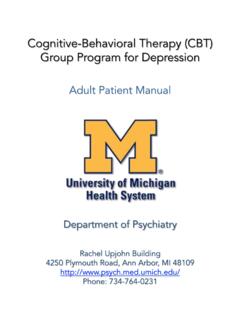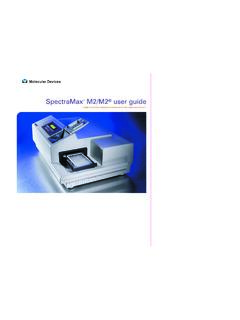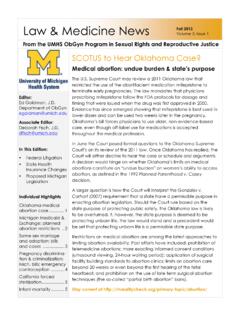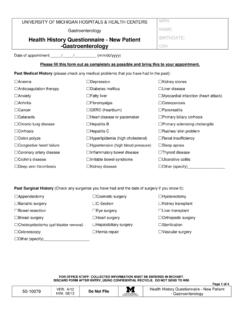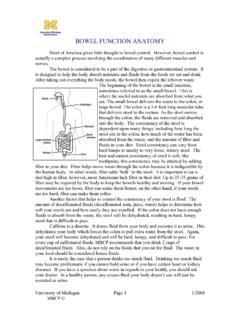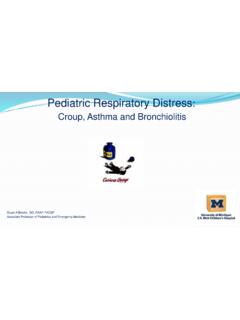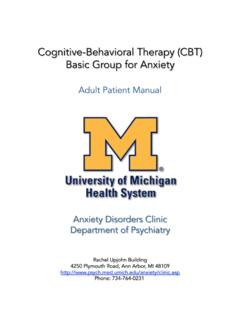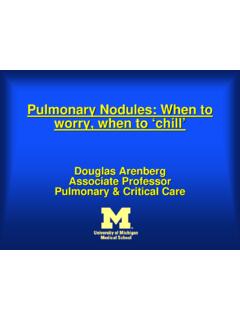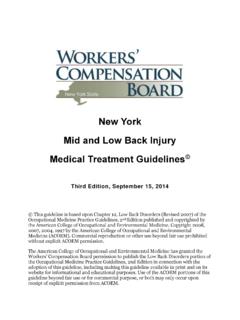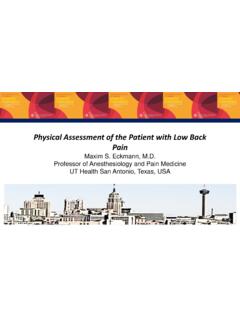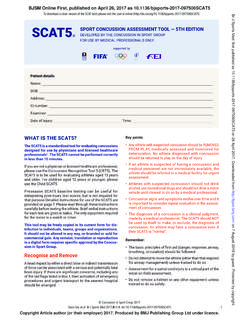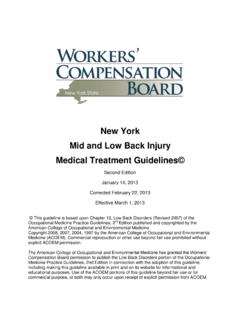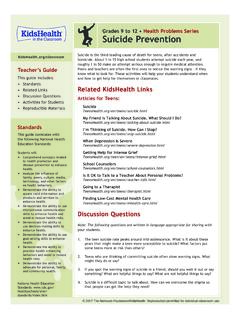Transcription of Prescribing Medications for Anxiety and Depression ...
1 Prescribing Medications for Anxiety and Depression (without getting anxious and depressed)Stephen Warnick Jr., ProfessorDepartments of Family Medicine and PsychiatryDisclosures None2 Learning Objectives At the end of this session you will be able to: Use first and second-line treatments for Depression and Anxiety , including Medications for augmentation of partially effective meds. Manage common side effects of Medications for Depression and Anxiety . Develop a differential diagnosis for reasons why treatments are not working as expected for Anxiety and Depression . 3 Psychopharmacology ATTACK! Lots of info in next 30 minutes! We will process more in the breakout session!4 Session Structure First line treatments for Anxiety and Depression (15 minutes) Augmenting/second line treatments for Anxiety and Depression (10 minutes) Why is my patient not getting better? (5 minutes)56 First Line Treatments for Depression and AnxietyAnxiety and Depression First Line Treatment Mild-to-Moderate Based on symptoms or PHQ-9/GAD-7 Score PHQ-9 under 10 for Mild, under 20 for Moderate (15-19 Mod-Severe) GAD-7 under 10 for Mild, under 15 for Moderate Cognitive Behavioral Therapy is a good option Medications often are not required for MILD Anxiety or Depression Moderate-to-Severe Medications : SSRIs first line medication treatment Try one at a good dose, give it at least 4-6 weeks Partial response: increase dose and/or Augment No response: go to 2ndSSRI7 RL, Kroenke K, Williams JB, Lowe B.
2 A brief measure for assessing generalized Anxiety disorder: the GAD-7. Arch Intern Med. 2006; 166 and Depression First Line Treatment KEY RESOURCE: University of Washington AIMS Center Treat to Target! Value of care management (collaborative care) What is remission? Many use PHQ9<5 for Depression as remission. Antidepressant that is partially effective (>25% but <75% reduction on PHQ9/GAD7 score), consider increasing dose or augmenting with another medication. Antidepressant that has not been effective (<25% reduction on PHQ9/GAD7 score) after an adequate dose/time (usually 4-8 weeks), consider changing antidepressants. Ask the patient8 AIMS Primary Care Prescribing Information9 SSRI Pearls Higher than FDA-recommended may be needed Maximum benefit up to 250 mg equivalents of imipramine in metanalysis1 250 mg of imipramine=300 mg of sertraline=250mg of fluvoxamine=50 mg of paroxetine or fluoxetine= mg of citalopram= mg of escitalopram Anxiety disorders start really low dose Blunting of affect at higher doses Bruising (platelets have 5HT receptors!)
3 , hyponatremia in elderly STAR-D trial showed maximum benefit after TWELVE weeks! Celexa over 40 mg (20 mg for geriatrics) VA demonstrated worse outcomes when celexa doses lowered2 UM study showing higher healthcare utilization and higher sedatives when dose changed3 Baseline EKG if going over these doses and recheck EKG, keep K/Mg stable101. Jakubovski E et al. Systematic review and meta-analysis; Dose-response relationship of Selective Serotonin Reuptake Inhibitors in Major Depressive Disorder. Am J Psych. 2016 Feb 1; 173(2) Rector et al. Outcomes of citalopram dosage risk mitigation in a veteran population. Am J Psychiatry. 2016 Sept 1;173(9):896-902. 3. Gerlach et al. Unintended Consequences of AdjustingCitalopram Prescriptions Following the 2011 FDAW arning. Am J Geriatr Apr;25(4) Co-morbid pain and Anxiety / Depression consider 1stline Cymbalta to 120 mg Better outcomes with pain at 120 mg1 Effexor to 300 mg in XR, 375 in IR Effexor does not hit NE until 150 mg and above (SSRI like before 150mg) Same time course as SSRIs May increase BP May be more effective for severe JP et al.
4 (2013), Comparative Efficacy of Oral Pharmaceuticals for the Treatment of Chronic Peripheral Neuropathic Pain: Meta-Analysis and Indirect Treatment Comparisons. Pain Med 2013;14: 706 719. AJ, Lenox-Smith AJ. Does adding noradrenaline reuptake inhibition to selective serotonin reuptake inhibition improve efficacy in patients with Depression ? A systematic review of meta-analyses and large randomized pragmatic trials. J Psychopharmacol. 2013 Aug;27(8):740-58. Mirtazapine Sedating More sedating at lower dose (higher dose NE kicks in) Increased appetite Weight gain will not be subtle unlike atypical antipsychotics12 Buspirone Can augment SSRI for Depression and Anxiety If it works, it works! Does not work well for people who have BDZ exposure already1131. Chessick CAet al. Azapirones for generalized Anxiety disorder. Cochrane Database of Systematic Reviews 2006, Issue 3 Trazodone Approved for Depression (higher doses) Mostly used for sleep SE: sedation, orthostatic hypotension/dizziness, priapism PEARL: 150 mg often scored in half one side, in thirds on other side (makes flexible dosing easy)14 New(er) Agents Vilazodone SSRI and 5HT1A partial agonist (Like Buspar and SSRI in one) GI SE most common, headache Levomilnacipran SNRI (enantiomer of milnacipranwhich is approved for fibromyalgia) More heavy on norepinephrine, so more HR/BP/urinary hesitancy issues Vortioxetine Trade name changed from Brintellix to Trintellix SSRI, 5HT1A full agonist, 5HT3 antagonist Increases dopamine, NE, Ach in prefrontal cortex Could this be good for improved cognition in Depression ?
5 3 RCTs say so1 Studied in geriatric patients and shows RS et al. The effects of vortioxetine on cognitive function in patients with major depressive disorder: A meta-analysis of three randomized controlled trials. Int J Neuropsychopharmacol. 2016 Aug 24. Great for low energy, smoking cessation, low concentration Off-label use for ADHD Does NOT help out generalized Anxiety and may make Anxiety worse THREE FORMULATIONS: Immediate release (TID) Sustained release (SR BID) Extended release (XR qday) When dosing TID or BID, do not dose too close to bed BID= qam and qdinner (9AM, 5 PM)16 Tricyclic Antidepressants Effective dirtier drugs re: receptor affinities More SE than SSRI and SNRI Dry mouth, sedation, constipation, urinary retention, blurry vision, orthostasis Lethal in overdose (as few as 10 day supply can be lethal) Benefit with chronic pain Nortriptyline often tolerated better than amitriptyline Lower doses for pain; higher doses for Depression EKG at baseline and annually if over 65 yo, cardiac diseases Can test blood levels!
6 17 Complementary and Herbals We are in Ann Arbor after all! Carlat Report Psychiatry July/August 2013 still one of best resources Depression effective and safe: Rhodiola rosea (300-900 mg), SAMe (200-800 mg BID) St. John s Wort as well, but interacts with SSRI/serotonin agents 5-HTP may help but TID-QID Methylfolate may help Depression as adjunct Fatty acids possible; 1-2 grams Kava helps Anxiety but not safe (hepatotoxic) Valerian may help insomnia but poor studies1819 Augmenting Agents for Depression and AnxietyBenzodiazepines20 Lipophilic-diazepam, alprazolam Hydrophilic lorazepam, clonazepam Oxazepam, temazepam, lorazepam safer in liver disease Risk Assessment for BDZ Abuse: Higher risk if h/o alcohol use DO, FH of alcohol use DO Risk of accidental OD with Opioids red flags Unwilling to try other treatments Urine GCS will catch alcohol metabolites! BDZ in Depression may help patient stick with other meds short term1 Lower risk if using PRN; Some patients use as back -up coping mechanism UK NICE guidelines recommend 2-4 week treatment, not for mild GAD1.
7 Furukawa TA et al. Antidepressant plus benzodiazepines for major Depression . Cochrane Database of Systematic Reviews 2001, Issue 3. Atypical Antipsychotics FDA approved for augmenting Depression (as of 7/2017): Aripiprazole Brexpiprazole Olanzapine Quetiapine XR None FDA approved for augmenting Anxiety Off-label use for quetiapine doses from qhs to even TID dosing May be similar to SSRI effect BUT HIGHER SE PROFILE! AM et al. Second-generation antipsychotics for Anxiety disorders. Cochrane Database of Systematic Reviews 2010, Issue 12. Art. Atypical Antipsychotic Pearls High Metabolic Risk: Olanzapine, Clozapine Medium Metabolic Risk: Quetiapine, risperidone, asenapine, iloperidone Low Metabolic Risk: Aripiprazole, Brexpiprazole Lowest Metabolic Risk: Ziprasidone, Lurasidone Ziprasidone and Lurasidone need to be taken with food (300 cal) Augmenting doses are on lower end of spectrum; bipolar doses mid-range; schizophrenia doses highest22 Atypical Antipsychotic Pearls Most Sedating: Quetiapine, Olanzapine, Clozapine Don t forget Akathesia (looking at you aripiprazole) Reduce dose, add low dose BDZ or propranolol, switch agents METABOLIC MONITORING FOR ALL23 Atypical Antipsychotic Metabolic Monitoring24 Other Augmenting Agents Can mix and match MOST groups of antidepressants SSRI/SNRI/TCA together to not make much sense (maybe low dose TCA) We didn t discuss MAOIs do NOT mix serotonin meds with MAOIs!
8 Mirtazapine for Depression / Anxiety Bupropion for Depression (can worsen Anxiety ) Buspirone for Depression / Anxiety Low dose stimulants for geriatric depression1 5-10 mg of methylphenidate; up to 40 mg Gabapentin for Anxiety (off label use) Hydroxyzine for PRN use Anxiety Lithium for unipolar Depression (per STAR*D) Cytomel (T3)for Depression (per STAR*D) STAR-D: Lavretsky H et al. Citalopram, methylphenidate, or their combination in geriatric Depression : A randomized, double-blind, placebo-controlled trial. Am J Psychiatry 2015 Jun;172(6):561-926 Why is My Patient Not Getting Better?Reasons for Treatment Failure Is the dose high enough? Has the treatment been long enough? Instant gratification does not work with SSRI/SNRIs Do you have the correct diagnosis? Could this be bipolar Depression ? Hypomania often undiagnosed and unrecognized. Bipolar Depression notoriously difficult to treat. What are the refractory symptoms?
9 Attention? Irritability? Consider co-morbid ADHD Irritability? Mood Swings? 0 to 60 in seconds ? Consider Personality DO Trauma? Irritability? Avoidances? Nightmares? Consider PTSD27 Reasons for Treatment Failure Chronic Pain Is there a medical cause? Thyroid? Brain tumor? Revisit your review of systems Are they taking their meds? Are meds affordable? (Donut Hole, loss of insurance) Culture is mental illness accepted? LARGE placebo effect in psychiatric Medications Ifyouundersellmeds,theywillnotworkaswell 28 Tools to Help PHQ-9 ( Depression ) GAD-7 ( Anxiety ) Mood Disorder Questionnaire (bipolar not good universal screen) CIDI (Structured bipolar screening) PC-PTSD (Primary Care PTSD screen) PCL-5 (PTSD symptom scale LONG) Adult ADHD Self-Report Scale AUDIT and AUDIT-C (alcohol screening) DAST-10 and DAST-20 (Drug abuse screening) https:// sites/default/files/ Spitzer RL, Kroenke K, Williams JB, Lowe B. A brief measure for assessing generalized Anxiety disorder: the GAD-7.
10 Arch Intern Med. 2006; 166:1092-1097 STAR-D Jakubovski E et al. Systematic review and meta-analysis; Dose-response relationship of Selective Serotonin Reuptake Inhibitors in Major Depressive Disorder. Am J Psych. 2016 Feb 1; 173(2):174-183 Rector et al. Outcomes of citalopram dosage risk mitigation in a veteran population. Am J Psychiatry. 2016 sept 1;173(9):896-902. Gerlach et al. Unintended Consequences of AdjustingCitalopram Prescriptions Following the 2011 FDAW arning. Am J Geriatr Apr;25(4) Ney JP et al. (2013), Comparative Efficacy of Oral Pharmaceuticals for the Treatment of Chronic Peripheral Neuropathic Pain: Meta-Analysis and Indirect Treatment Comparisons. Pain Med 2013;14: 706 719. Bradley AJ, Lenox-Smith AJ. Does adding noradrenaline reuptake inhibition to selective serotonin reuptake inhibition improve efficacy in patients with Depression ? A systematic review of meta-analyses and large randomized pragmatic trials.
